Sadiq Khan, Mayor of London, recently released his new transport strategy and – in short – it looks fantastic. Crucially, the strategy recognises that transport is – literally – a means to an end and it really focuses on the question of how transport in London can contribute to that city being a great place. Here’s a snippet from the executive summary:
The Mayor’s Transport Strategy is the statutory document that sets out the policies and proposals of the Mayor of London, Sadiq Khan, to reshape transport in London over the next 25 years. It builds on the vision for a better London that the Mayor outlined in ‘A City for All Londoners’, and takes forward the approach set out in ‘Healthy Streets for London’. It is an ambitious strategy that puts people’s health and quality of life at the very heart of planning the city’s transport. Along with the new London Plan and the Mayor’s other strategies for economic development, the environment, housing, health inequalities and culture, it provides the blueprint for making London a city that is not only home to more people, but is a better place for all of those people to live in.
The challenges facing London are in many ways similar to those faced by Auckland. Rapid growth, limited space for building more roads, a need to reduce pollution and have the transport network play a much greater role in supporting great places – “healthy streets”. But unlike strategies in Auckland, which often seem apologetic (yeah we want to improve public transport but we don’t want to say that too boldly) the London transport strategy is unapologetic in its boldness:
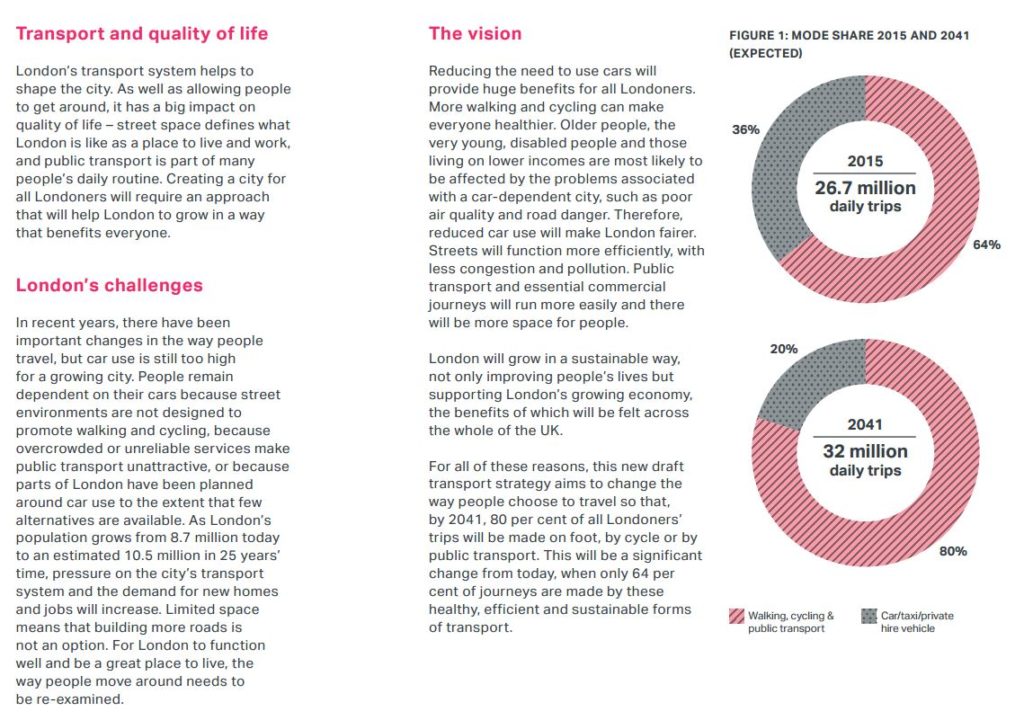
What’s great about the strategy is how it clearly cuts to the point – modal shift towards public transport, walking and cycling. Such a strong, singular goal permeates throughout the plan and it is clearly explained how a modal shift is crucial to achieving all the goals of the plan.
The other core part of the strategy is its focus on the broad role of streets in supporting a healthy, vibrant city – not just as ways of shifting cars. This “healthy streets” focus is certainly something Auckland could learn a lot from:
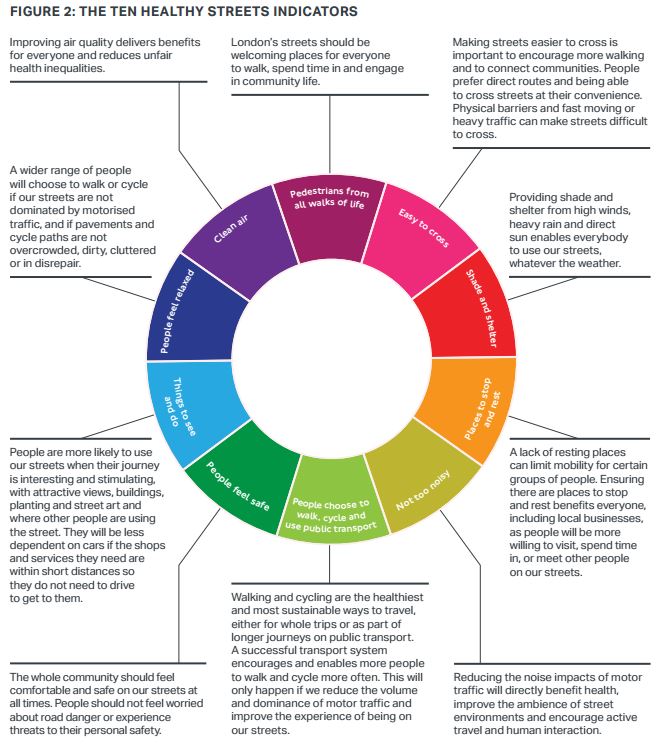
There are also some great concepts for what a healthy street looks like. Cars are still welcome but definitely “put in their place”:
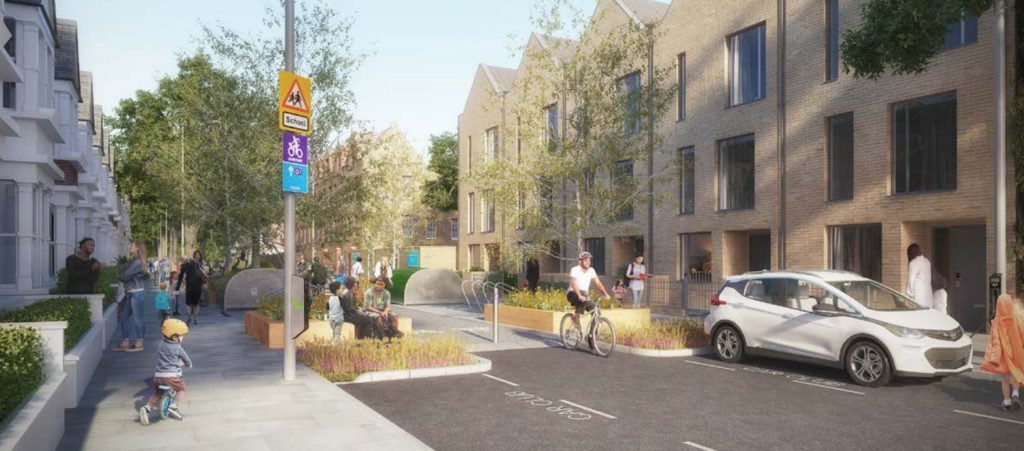
The big new project sitting at the heart of this plan is Crossrail 2 – a major new southwest-northeast rail corridor across Central London. Like the Elizabeth Line (formerly known as Crossrail) the scale of the project is immense (projected cost somewhere around £30 billion), putting some of our own investments into perspective:
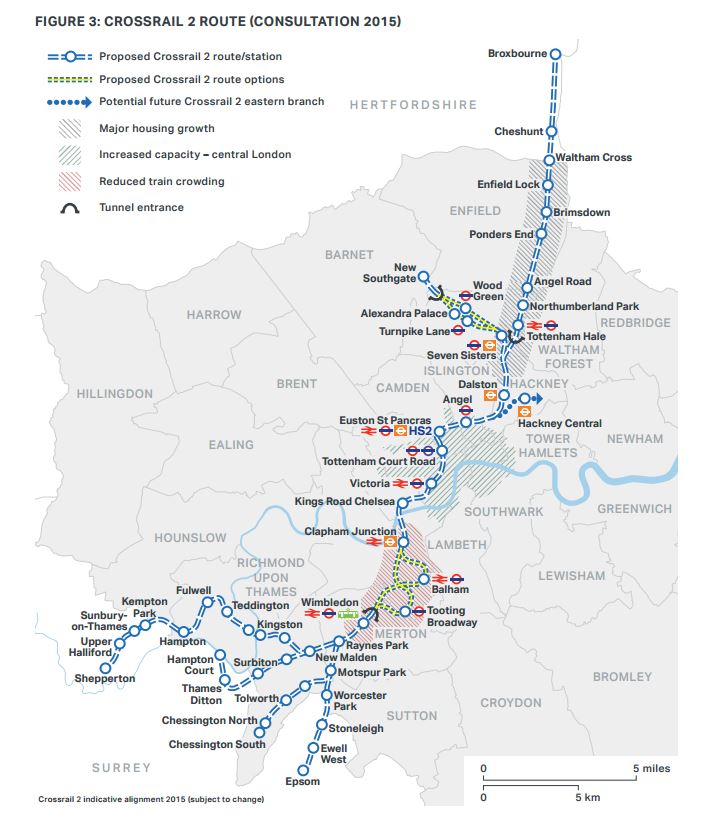
There are some great goals embedded in the plan, including a strong “Vision Zero” commitment:
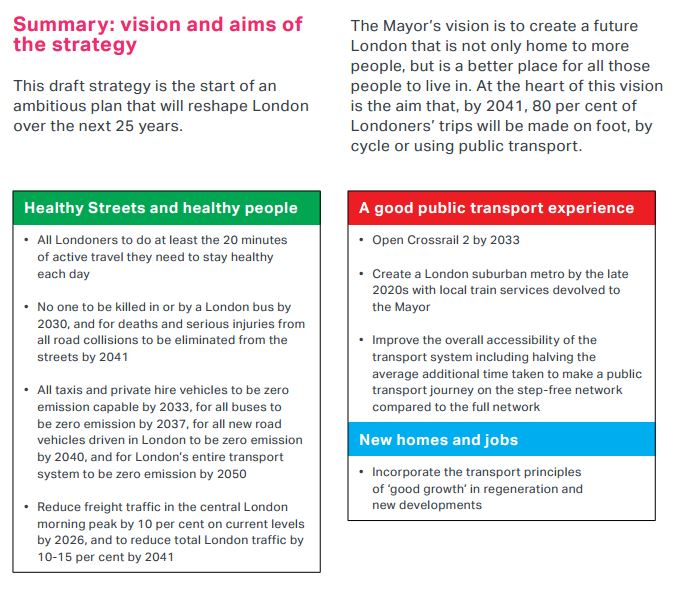
The obvious question is “how applicable is this to Auckland?” Obvious London is of a completely different scale in terms of its size, density and its extremely extensive and well developed public transport system. Yet much of the plan is really talking about what happens at the more local level, about considering streets as places and not traffic sewers and about recognising the outcomes of a good transport strategy are broad – supporting a healthy city, a safe city, reducing emissions, providing good travel options for all and supporting growth. It’s perhaps the clarity of the strategy which stands out – an over-arching goal of 80% of trips being by PT, walking and cycling.
Auckland’s most recent exercise in strategy transport planning – the Auckland Transport Alignment Project – is interesting to compare against this London Transport Strategy. On the one hand ATAP was incredibly conservative and full of compromise (unsurprising given its role). Road projects were still included, even though analysis said they probably weren’t necessary, the strategic direction seemed to think some of our arterial roads can become mini-motorways and it had a weird obsession with greenfield growth. But on the other hand it locked in a massive expansion of our strategic public transport network, confirmed the motorway network is now basically finished and proposed an extremely comprehensive form of road pricing.
Later this year a review of the Auckland Plan will update Auckland’s strategic approach to transport. We will follow its development closely and certainly hope it will be as bold and clear as London’s new transport strategy.

 Processing...
Processing...
As a former temporary resident, no city’s transport initiatives have got me more excited than London’s. While I always had a lot of respect for Boris Johnson in the developments under his tenure, I cannot think of a better person than Sadiq Khan to roll out the future of transport for London. In ten years time the city will be a whole different place to get around in.
When I left, the first New Routemaster was in place on route 24, now the bus is rolling on approximately 30 other routes, and fully electric buses are the next phase (including one already on route 312 in Croydon). The number of buses on Oxford Street has been curtailed (making the street far more pleasing for pedestrians) and the Elizabeth Line (Crossrail 1) is opening next year. And for cycling this was a fantastic city to get around in.
Well there’s a new one: “respect” and “Johnson” in the same sentence.
This is the same man who has twice been sacked for lying to his employers, no?
Spent millions on a ridiculous bus with a platform that is permanently closed?
Called Africans “piccaninnies” with “watermelon smiles”?
Cheated on his wife?
Took credit for hire bikes that were Livingstone’s project?
That Boris Johnson? You have respect for him?
The tube improved immeasurably under Johnson.
Whatever his personal life faults has little to do with this.
If you want to throw stones I would suggest you look at how the current Muslim mayor has said terrorist attacks are just part of living in a big city! Completely disgusting comment.
Johnson’s a massive idiot, certainly a bit racist, and as previously mentioned an adulterer..he’s certainly not suited to being Foreign Secretary or god forbid the PM (see his latest BBC radio interview for even more confirmation of this). However, as someone who lived in London 10 years, and experienced both Livingstone and Johnson as mayor, I was pleasantly surprised with how things went under his tenure as we expected it to be a complete disaster. Sure, he probably did take credit unduly for some projects and initiatives which were already well under way under Livingstone, but at least he managed to not completely **** things up. I realise this is a low bar of achievement, but it couldve been much much worse.
Sadiq Khan, on current evidence, has been an excellent mayor. His comments about terrorism being part of big city life, in this current climate, are completely accurate. They don’t detract from any efforts to stop terrorism from occurring in London or anywhere else in the UK.
Yeah Boris is a terrible person but he was a pretty good mayor.
What the hell does his religion have to do with anything?
I live in London. Terrorism is a real thing we have to deal with day-to-day, at least in terms of transport. It is a part of living in a big city, especially the most terrorised city in the entire world for all time.
You are a moron. The comment was completely taken out of context and you know it
Crossrail 2 is great news. Let me see Crossrail took about 75 years to plan and build so Crossrail 2 should be opening around 2092. Go London!
Actually Crossrail 2 has been planned since around 1970 (originally as the Chelsea-Hckney Line) so 2045 might be a better bet 😉
It’s going to be a difficult task as London streets are absolutely crammed with cars. Curiously though, relatively few used for commuting. People own a car but don’t use it to get to work so it just sits by the kerb (almost no one has a garage) racking up insurance costs and gathering dust and depreciation – very different from Auckland. I think many Londoners would happily give up their cars as long as they can get their groceries delivered and have some way of getting away for the weekend. But Auckland needs massive change in PT to be able to get cars off the road.
Sounds like they need what my family needs too – a suburban-based car share that is economical for both short errand-type trips, and occasional 2, 3 or 4 day trips away.
Another difficulty to giving up the car is that it’s almost impossible for our children to learn to drive unless we keep it. They have no interest in driving, but will need a licence to get jobs. A car share or rental car that allows people with restricted licences to hire (sure, at a higher rate) would be really good. (I’m not suggesting this for those on learner licences; at that stage it’s probably reasonable to have to use a private car and / or pay for driving lessons).
For weekends you just need to hire from one of the regular rental companies I reckon. We did that for several years after getting leaving uni; even if the rates feel high when you pay the bill, it’s way cheaper than owning a car just for weekends, and you usually get a better, newer car than you’d buy yourself.
Find a way to get Cityhop into your ‘hood and you’ll have all the bases covered. Alternatively, smaller local rental companies often hire by the 4 hours (eg James Blond are handy for anyone from Avondale to Henderson, or the guys at Valley shops on Dom Road for central burbs) if you ever need to do the DIY store run or similar.
Yes I might look at bringing Cityhop in. Our Transition Town has been talking about carshare for ages (as we do with small and large tools, and a trailer), but maybe using the expertise of Cityhop is a better way for us to go.
Why do they need a license to get a job? and if they are currently in school, will it have changed by the time they need to seek employment?
Living in Sydney, I don’t own a car and the cost savings are huge. I occasionally hire a car (twice in the last two years), but a little thinking and planning reduces the need. Quaxing does indeed have it’s benefits.
I might not have been able to do that while I lived in Auckland, but how i think about transport has changed in the last four years, so I’m expecting that if I moved back I’d reconsider how that would all work.
OK I admit I haven’t been in the job market for a while. Back in “my” day, I never saw any job that I was interested in that didn’t require a drivers’ licence though. Not that most of them required you to actually drive. Have things moved on?
Sort of, I don’t think I’ve ever had a job that required a drivers license as part of the application process and by all accounts I’ve done some interesting things. To drive a work vehicle you needed the appropriate license for the vehicle.
Going forward what will the expectation be? Will your children be expected to be able to drive in order to gain employment?
I’d guess that in major metropolitan areas, which Auckland is developing into, this won’t be a competitive advantage as it has been in the past and part of that is how we think about the issue and the expectations we continue to hold.
I’ve never seen a job description requiring a license for a job that doesn’t involve driving. Is that even legal?
(Based on anecdotal evidence admittedly) likely not much Heidi.
There still seem to be plenty of employers who use having a licence or not as a sorting mechanism.
Only when it is politely pointed out to them (difficult for the candidate themself to do) that the job does not require driving and the candidate can easily get to work by PT/cycling etc. do they usually relax and focus on a candidate’s actual suitability for the job.
Perhaps an area which transport campaigners could have a think about?
I think it does depend on the type of job they find- when I first left school I worked in construction and cycled to the depot where all tools etc where stored. As labourers we then hopped in the firms truck and went out to jobs. Nowadays many workers are expected to meet on site and bring all their own tools, and we see large trucks “stored” overnight on our residential streets.
Seems that there is a niche here for someone to develop an e “shopping trolley”. Something that can follow you home then return to a depot when the streets are quite.
https://shop.countdown.co.nz/Shop/Page/Delivery
Niall’s suggesting something cooler than that though. A self driving shopping trolley that returns to the supermarket when there are less people out and about. I like it. Mind you, having someone at the supermarket with a rickshaw would be cool too. Anyone use the lockers where you can pick up your groceries at:
Albany Bus Station
New Lynn Transport Centre
Orakei Train Station
Matiatia Ferry Terminal (Waiheke Island)
Downtown Car Park
http://www.countdown.co.nz/news-and-media-releases/2016/september/click-commute-and-collect
The thing is that car ownership and car use are not the same thing. The Dutch actually own more cars per capita than Britain but choose to take a lot more trips by bicycle and public transport. Amsterdam streets are full of parked cars, surprisingly so, I would say.
Cars are great for a wide range of trips involving long distances, multiple people or heavy loads. However, those trips tend to only be a minority of car trips so in NZ we are using them for all trips.
London already has 64% of trips other than by private car, whereas Auckland is more around 85%. So we have a long way to go to just get to where London is now. So yes, Auckland has a long way to go to where London (or even Melbourne) is now.
Goosoid – “London already has 64% of trips other than by private car, whereas Auckland is more around 85%”
London’s 64% is a great testament to the many city journeys can be made without a car, and great too that they plan to increase this figure.
But Auckland more around 85% ??? Shouldn’t that be, more around 15%?
This sums up why I think Auckland needs to be bold and invest in a proper heavy rail solution along slide the light rail in the central isthmus only.
In saying that I have submitted as a guest blog why I think heavy rail is a better vision for Auckland to this blog twice now and not had a single reply, let alone it posted. Not only does it seem quite rude it does seems that contrary to to what they say, the people running this blog don’t like a differing view which is a shame.
Hi Adam, where did you send it, I don’t recall seeing it so can assure you, you haven’t been ignored intentionally. I wonder if it got caught up in the crap load of spam post offers we get (normally get multiple daily). Fill in the contact us form and I’ll get in touch.
https://www.greaterauckland.org.nz/contact-us/
Matt you should add reCaptcha to that contact form to cut down on the spam
I sent my guest post to the e-mail ”admin@greaterauckland.org.nz’ I found somewhere twice now.
I can post it into your comment box if that is what you need’
OK my guest post has been in the ‘my message’ box.
Cheers,
Matt, did you get my guest post now? – this being the 3rd attempt to send it to you.
No surprises there. HR is known around the world as being the best high capacity option yet it is a dirty word here except in regards to the existing network. When I first started reading this blog however HR was considered an option by most (NS Line, Airport Line, Mt Roskill Spur).
Yes London is a completely different scale… it also has multiple HR lines (9 Overground, 11 Underground + Crossrail/Liz, 14 National Rail Lines. Many of which have multiple spurs also. Total HR Lines 35 for a population of 8.7 million or one line per 248,571 people.
Auckland has sortof 4 HR lines (really just 3) with a population of 1.7 million or one line per 425,000 people. So even building the NS line and airport line would make it one line per 360,000 people (assuming a population of 1.8 million people. London also has other lines on top of these (DLR, Skyline, Trams) as well as a massive bus network and ferry services.
I don’t know much about trains, AKLDUDE, beyond what I learnt in Thomas the Tank Engine. I’d very much like to read a post from you on the subject. If you’ve already written one, can you give me a link? Cheers.
No Heidi I have not written a post on the subject, just many comments (and the comments being shot down by posters on here because it doesn’t agree with their myopic focus on LR only over HR is what I am referring to).
Plenty of resources out there for you to read about HR if it does interest you. Or you can take an empirical (a favourite word of several commentators) view of it and see how almost all cities around the world have been investing in HR because it is the only mode with the capacity for future growth. Based on the London ratio the North Shore and Rodney would have 2 HR lines for example. East Auckland would have a line as would the airport.
Just sounds like you are lazy tbh
and there it is… the sarcastic shoot down – thanks Harriet. How is that high horse going?
You are upset that Harriet is shooting down your personal attacks?
PS, you still haven’t demonstrated that HR would be faster, or that it would have more capacity in our specific context.
I have my high unicorn thank you.
If you can’t even be bothered writing a guest post & just spend all day whining about immigrants & every post do you really deserve anything more than a sarcastic shoot down.
Why don’t you write a guest post or start your own site put some effort in easy to whine behind your keyboard, harder to actually do something.
Oh no. Here we go again.
“Light rail is faster and better”.
“Oh no it isn’t!”
“Oh yes it is!”
(Quiet please, children!)
In answer to Sailor Boy, Heavy Rail will be faster and have higher capacity than Light Rail if it is designed to be. It will not hit the same speed- and capacity-ceilings that Light Rail in-the-street will unavoidably hit. But if it is given an unnecessary handicap of some sort then yes, the advantage may be lost.
Satisfied now?
Not happy.
Your summary paints the two sides of this debate as even when one side has expert evidence.
Also you describe the physical reality of the existing track formation as “an unnecessary handicap of some sort”.
Expert evidence? Do you mean the SMART study which showed an obvious optimism-bias towards LR? This was akin to the Public Transport Spine Study in Wellington which set out to demonstrate an already-preferred conclusion and has since been largely discredited.
By ‘unnecessary handicap’ I was thinking more in terms of the conservative operating practices which have served to make the current trains slower than the old ones, largely because of prioritising safety far above anything you will see on the roads (including Light Rail). Is it reasonable to exclude a superior mode from consideration, because it has been made disporportionately safe?
But the track formation also is something that can be improved with funding, and this is a desirable goal whether or not more HR gets rolled out. Bear in mind that LRT has no tracks at all yet, and no proven track-record as to how it really will perform in the streets of Auckland (vis-à-vis what the study might claim). Wait till the safety culture clamps down on LR operation also!
The tube and the underground are Light Metro, not HR.
Deep tube – maybe based on tiny loading gauge, but legally heavy rail in the UK.
Sub-surface lines – definitely heavy rail, Metropolitan historically had bigger loading gauge than NZ heavy rail …
No Patrick. The Tube and the Underground are definitely heavy rail, and in places share tracks with main line trains. Although not as heavy as our EMU’s, their operation is very-much conventional (‘heavy’) metro.
wrong Patrick they are most definitely HR. More so than our HR in most cases actually.
There is a grand total of one line that isn’t HR, that being the DLR.
And the Croydon Tramlink makes 2
Croydon Tram isn’t part of the list of 11 underground lines. So is 13 lines if you want to include that and DLR (plus the overground and National Rail lines).
London builds a new CRL type project pretty much once a decade. Crossrail is also overshaddowing another tunneling project tube extension to serve battersea concurrently.
working on expanding the Bakerloo south and the DLR to the south-east within the next 10 years as well. An expansion of the Overground in Barking is also about to be completed.
Would be nice if they ever finished that proposed Bakerloo line extension to Bromley.
Its amazing how quickly some of these cities are improving. When I lived there 10 years ago bikes were quite common, but nothing like it is now, they are just everywhere!
Sometimes this blog over estimates how well Auckland is progressing. Yes we have some new cycling infrastructure (most of it built to make a motorway project seem more friendly), yes we have some double decker buses, yes we have greatly improved our existing rail network. But I think we are actually falling further behind more progressive cities rather than catching up.
The main problem is the government who still honestly think more roads is the solution – it makes you wonder how stupid our ‘leaders’ (and voters) are. But AT aren’t that much better – a lot of talk about PT, but still most of the money goes into roads. And the council talk even more about PT, but they don’t force AT to act.
Almost every AT project is many years late. Almost every new roading project advertises the minutely small contribution it is making to PT and active modes (even the east west link).
Our ‘leaders’ are lying to our faces while pushing Auckland further and further behind other cities, increasing congestion, pollution, and the cost of housing.
Yes they know PT and active modes sound good to voters, but spend much much more on roads.
Auckland could start by acknowledging that it has been the road building that has created the problem, and that this has to stop now. Projects like the East West Link have to be stopped, as they simply continue the same retrograde policy that has created car dependency to date.
Massive changes in PT are required – but it isn’t a money thing. We could entirely transform our transport networks by spending less than what they are currently spending on roads.
So we need a Sadiq Khan or a Sadik-Khan. Is there something in the name?
Luckily the easy west link will complete the motorway network 😉 Or is it part of the new expressway network?
I think it comes in either the Slot Car Original set or the Slot Car 21st Century set.
I think AT does the best they can with the budget available. But you are correct on the road/PT balance. Australia and NZ spend more per capita (and as a % of GDP) on new roads than almost any other countries in the OECD. Only a few gulf oil states beat us. We do not need to spend more on transport to get a decent PT system and good streets. We need to get some of the money we already spend reallocated away from roads driven by 1960s-type thinking.
It really comes down to individual attitudes and prejudices, not economics and engineering. If there was a good technical reason for the road projects, they would not need to hide the business case results I doubt many relevant ministers or NZTA officials have caught a bus in a long time.
Possibly premature praise. Reading comments from London, the community is very disappointed in Khan because he has put off already planned cycleways and improvements to placate NIMBYs. Many see this strategy as pie tomorrow that will continue to be delayed. Hoping to be wrong~
The crunch for deliverability of any plan is the detail on how it will be paid for. That being said, TfL has a substantial delivery capability. They could not pay for Crossrail 2 without central government support. But the rest they probably could.
I also wonder if the construction industry plays a part in always having another new road to build. Are they having an influence on politics to keep the whole thing going?
Understatement of the century, Luke. 🙂
Can’t understand why the construction industry cannot get equally excited about major new rail projects. Airport rail and North Shore rail should keep them occupied for a while. It doesn’t have to be just roads.
Does rail require the same amount of maintenance as roads, though?
No rail doesn’t however that should mean more money in the budget for construction rather than maintenance so they get to keep on building things.
but building more roads is the cash cow that keeps giving- they build- we get more congestion – so they “have to” build more, and round it goes.
and keep maintaining them, too. Gravy train.
You are correct and the rail projects actually generate more construction jobs. However some vested interests will be worse off and fight for road jobs. If you own a construction company with millions worth of road construction plant you want more road jobs. Also the big road jobs are so big that only 2 or 3 industry players can bid for them. Very cosy. Whereas a big rail job might require a completely different set of skills and firms in a bidding consortia. So workers get work either way, but the CEOs do not.
Meanwhile it doesn’t look very promising for the Croxley Link (Metropolitan Line extension). Partly for the pure reason that it crosses over an administrative boundary. – TfL Confirm Gap in Croxley Rail Link Funding – https://www.londonreconnections.com/2017/tfl-confirm-gap-croxley-rail-link-funding/
Going back bozo Boris… he only delivered Ken Livingstone’s strategy…. he bought nothing new to London, as he brings to the whole of humankind!